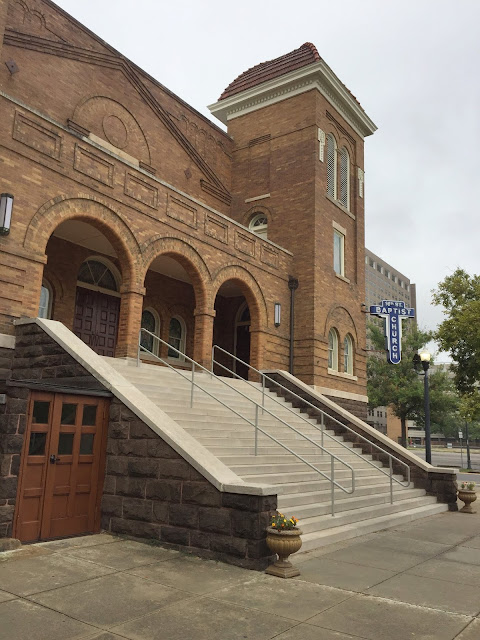Trip to Birmingham Alabama (1 of 3)
Trip to Birmingham Alabama (1 of 3)
We had the occasion to travel to Birmingham Alabama recently. Since this state, and especially this city, played a significant role in the civil rights movement, our trip wouldn't have been complete without a visit to the Birmingham Civil Rights Institute.
The stated goal of B.C.R.I. is: "to enlighten each generation on civil and human rights by exploring our common past and working together in the present to build a better future."( check out this link for more information- https://www.bcri.org/ )
The subject of civil rights stirs many emotions in American culture and it seems to be a topic this society is destined to examine and re-examine,... until we get it right. B.C.R.I. has done a great service in addressing this head on, in a clearheaded, dispassionate, and fact based manner.
After a brief film covering early history of the segregated South, the visitor moves on to exhibits which present life in the twentieth century. Displays that compare and contrast the circumstances and conditions of every day life for the African American and the white populations are particularly effective.
While you get a profound sense of the injustices and inequalities endured by the African American population, you also gain an appreciation for their community's resiliency and its determination to overturn those injustices. It is an undercurrent throughout the museum; this tension between the facts of oppression and prejudice and the vision of a better quality of life for everyone. It culminates in an exhibit on the challenges to human rights facing people around the world.
Note: African Americans met at the 16th Street Baptist Church to organize and strategize on the fight for civil rights. It was a gathering spot from which demonstrators would begin their protests in April- May 1963. The bombing of this church, on September 15, 1963, killed four teenage girls and hastened the enactment of federal civil rights legislation.
The historic 16th Street Baptist Church
(see note below)
Birmingham Civil Rights Institute, located
in the Civil Rights District of Birmingham.
The subject of civil rights stirs many emotions in American culture and it seems to be a topic this society is destined to examine and re-examine,... until we get it right. B.C.R.I. has done a great service in addressing this head on, in a clearheaded, dispassionate, and fact based manner.
After a brief film covering early history of the segregated South, the visitor moves on to exhibits which present life in the twentieth century. Displays that compare and contrast the circumstances and conditions of every day life for the African American and the white populations are particularly effective.
White schoolroom on the left, Black schoolroom on the right.
The exhibits are multilayered presentations. Overviews of the subject matter are in a large format and are accompanied by further explanations in a smaller format. More detailed information, (such as "hands on" displays and timelines), gives the opportunity to pause for in depth information at a point of interest. This allows the viewer to move at their own pace; one can either survey displays for a general overview of the subject, or gain more understanding at a microscopic level.
The presentations build on each other and the sense of tension grows until the viewer comes upon the exhibits covering protests, cultural clashes, and acts of violence.
Display covering the bombing of 16th Street Baptist Church pictured above.
While you get a profound sense of the injustices and inequalities endured by the African American population, you also gain an appreciation for their community's resiliency and its determination to overturn those injustices. It is an undercurrent throughout the museum; this tension between the facts of oppression and prejudice and the vision of a better quality of life for everyone. It culminates in an exhibit on the challenges to human rights facing people around the world.
Very worth the visit.
Note: African Americans met at the 16th Street Baptist Church to organize and strategize on the fight for civil rights. It was a gathering spot from which demonstrators would begin their protests in April- May 1963. The bombing of this church, on September 15, 1963, killed four teenage girls and hastened the enactment of federal civil rights legislation.






.jpg)


Comments
Post a Comment